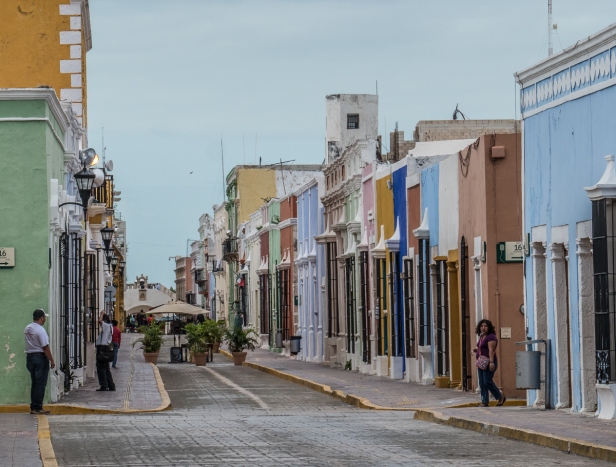
5-15 Jan 2017. Pirate: a person who attacks and robs ships at sea. Synonyms: freebooter, marauder, raider. Historical: privateer. Archaic: buccaneer, corsair.
Buccaneer: a pirate, originally off the Spanish-American coasts.
Back in the 1600’s the port of Campeche, on the west side of the Yucatan Peninsula in the Gulf of Mexico, was a dangerous place. During the colonial era the port was used to ship agricultural goods and hardwoods to Spain. Far more importantly the port was used to ship gold and silver, and there were plenty of pirates around who wanted a piece of the action. And the pieces of eight.
John Hawkins.
Francis Drake.
Diego the Mulatto.
Henry Morgan.
Cornelis Jol.
Bartolomeu Português.
Roche Braziliano.
Any one of these names was enough to evoke fear at the mere mention of it. These were brutal fearsome men who would stop at nothing to get the treasure; and there was frequently treasure being shipped from Campeche. Some did it for personal gain. Some did it for King and country. All did it with wild determination, and without mercy.
Fortification of the town began in 1610, but it was not sufficient. In 1663, pirates, led by Christopher Myngs and Edward Mansvelt, sacked and raided the city. Then in 1685 Laurens de Graaf and his men sacked the city and the surrounding haciendas, killing about one third of the population.
Naturally the people of Campeche were highly motivated to build some pretty serious walls around their town. By the time they’d finished it the wall was 2,560 meters (2,800 yards) long in a roughly hexagonal shape with eight defensive forts at the corners. All the forts, as well as some of the original walls are still standing.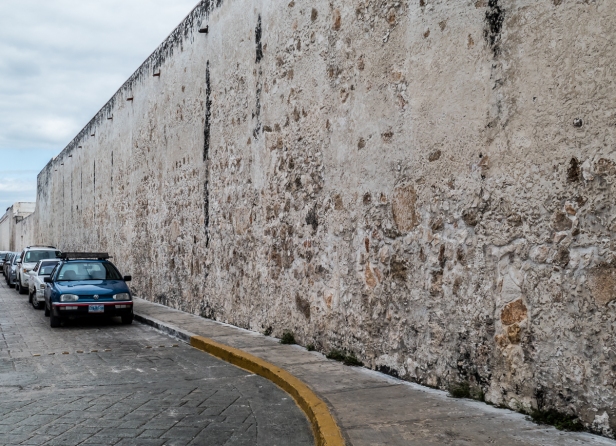
We arrive in modern Campeche by bus from Merida and take a taxi to our hotel in the old town. From the moment we enter inside the walls and see the impeccably restored candy-coloured streets we are smitten. What a perfectly beautiful place. We have no knowledge of its bloody and frightening past. We only know that we’ve stepped into a pastel-frosted fairyland.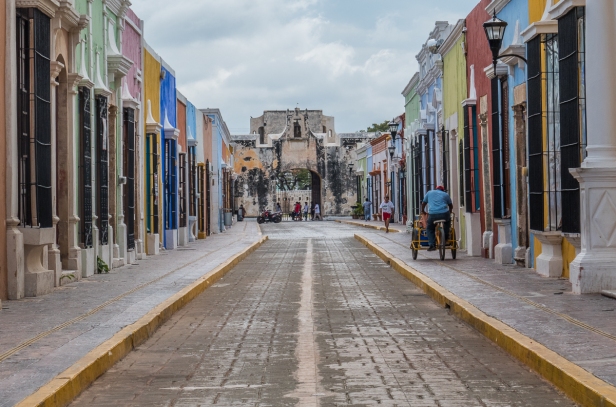
We have five days here and we do pretty much nothing but wander around the town softened by the sweetness of our surroundings. Our only excursion out of town is to the ancient Mayan city of Edzna. I never even go outside the walls to modern Campeche; Don ventures out a couple of times to get supplies from the big supermarket.
Most mornings we stroll to our favourite café, Luan, for a breakfast of fruit and yogurt, orange juice, and eggs with spinach in a cup of buttered bread nestled and baked in a ceramic pot. Best eggs ever.
We have lazy days at home catching up on writing and interneting, and lazy days and evenings strolling around the town, exploring slowly. We walk into buildings around the zocalo, or town square, because there’s nothing to stop us,
and after dinner wander back that way.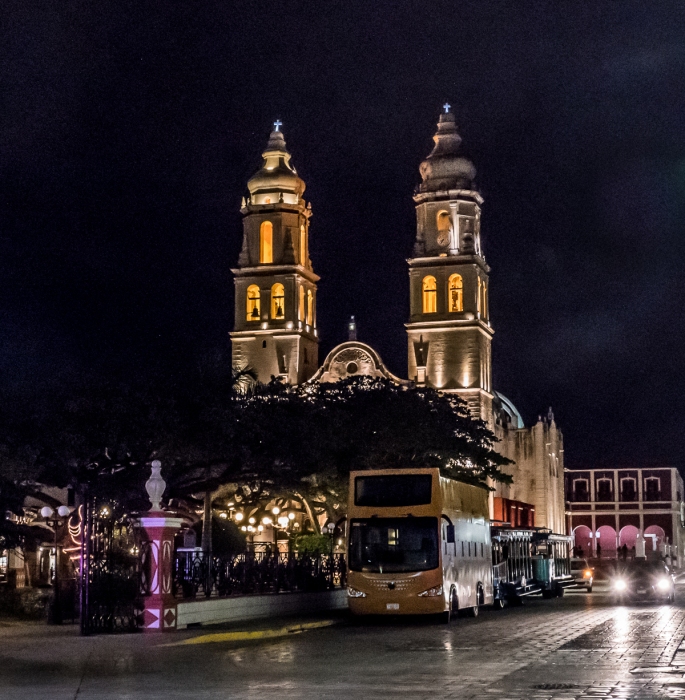
We stroll down to the “Sea Gate”,
and through it to the malecon, the long causeway by the sea.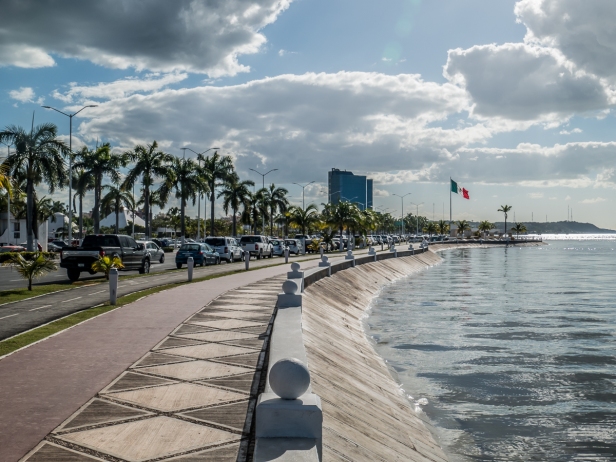
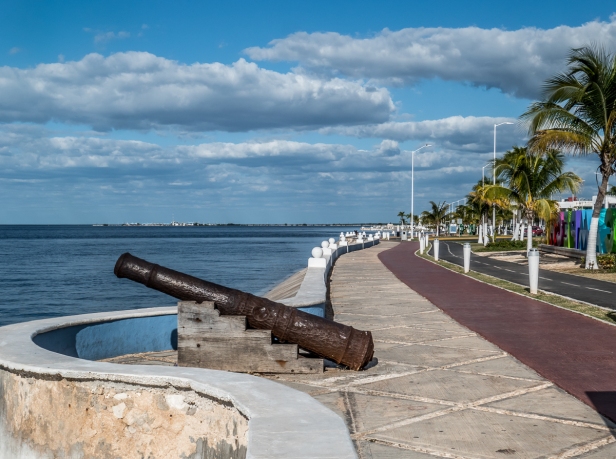
Walking in the other direction straight down the street for five blocks we come to the “Land Gate”,
and there go into one of the rooms of the original fortifications,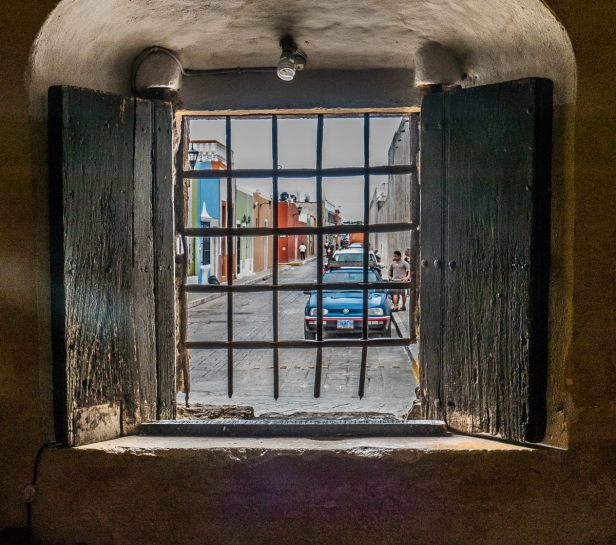
and then up onto the top of the wall where we can see the whole town spread out before us like a movie set.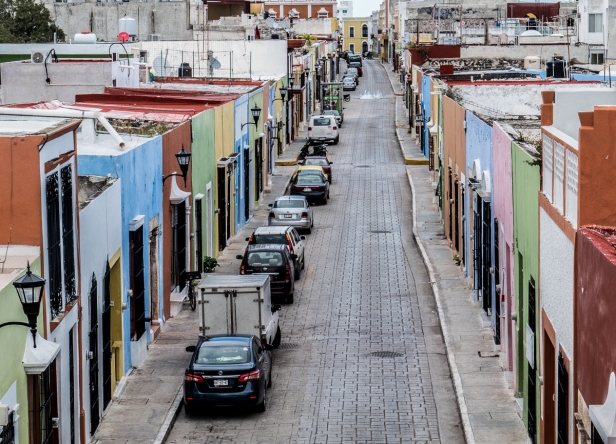

Every day we walk some, if only venturing out for meals, and in the process discover new places and people,


and every day most of the day we laze around with no agenda or need for one.
I never thought I’d say I’m grateful for oil money but it is oil money that preserved Campeche and led to it being declared a UNESCO World Heritage site in 1999.
The city was founded in 1540 by the Conquistadores at the site of the Mayan village of Can Pech. It became wealthy and important because of the port and remained so until the early 1800’s. The Yucatan port of Sisal opened in 1811 and took much of the business from Campeche, and with the abolition of slavery agriculture declined. Campeche’s reversal of fortune came with the discovery of oil just off the coast when a fisherman noticed an oil slick in 1971. Campeche now provides 70% of Mexico’s oil and is the top producer in the country. It is the prosperity that came from oil that allowed the The State Office of Cultural Heritage Sites and Monuments to buy abandoned properties and refurbish them as schools, museums, theatres, and a library. Over one thousand buildings and facades have been restored.
Outside the walls modern Campeche is a regular city, much like many other Mexican cities. Within the walls it is as if we have gone back in time, only now it is an oasis of calm, an unexpected dreamland with sophisticated cafés and restaurants, and the only pirates to be found are quiet companions.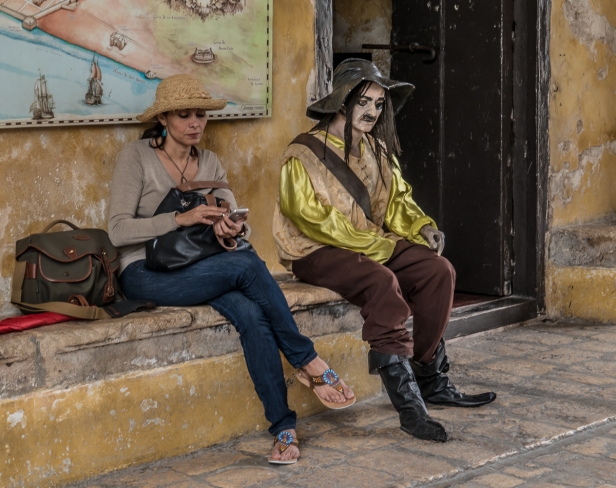
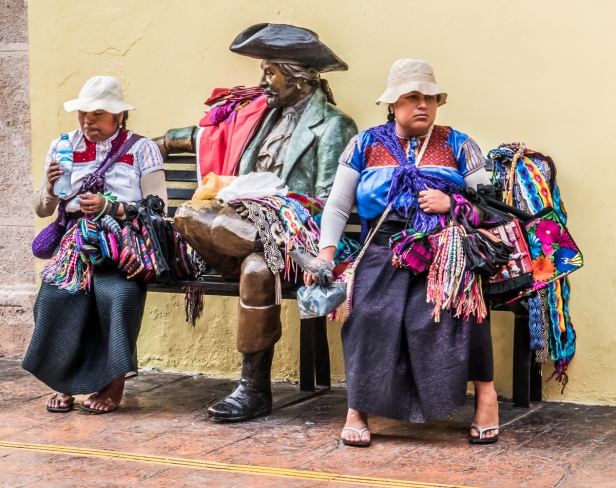
*************************************
We’d read that Villahermosa (beautiful villa) doesn’t live up to it’s name, but we decide to go there anyway for two reasons: it has an open air museum displaying the gigantic carved stone heads of the Olmec, one of the very early Mayan societies, and because we want to break the long journey from Palenque to Chiapa de Corzo.
The guidebooks are right about Villahermosa. The only saving grace is that Don had found a hotel on the lake, and because there are so few people staying there we are given the very best room on the fourth floor with a private balcony overlooking the lake.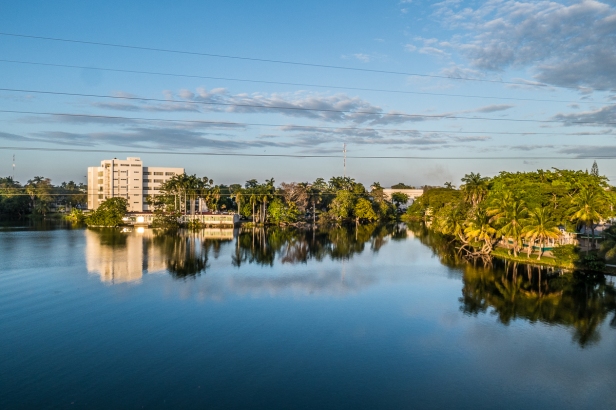
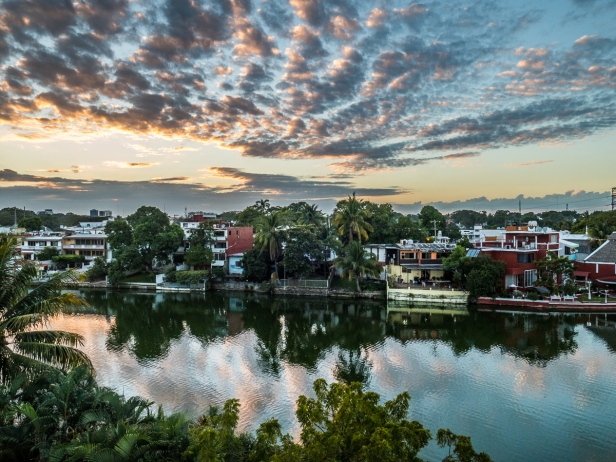
We are welcomed like royalty with very large glasses of red wine, which we decline. To drink any wine mid afternoon would do us both in for the rest of the day, but a whole goblet-full would probably have us comatose.
The woman managing the large, and largely empty, hotel explains that it had been her father’s, but he had not properly protected ownership of it. It’s all looking a little faded and shabby, and it’s a huge property to care for. Family members are employed there and are trying to make a go of it, but who wants to visit Villahermosa? The location of the hotel on the shores of the lake is lovely, the town itself not so much. It’s an average Mexican city. There’s nothing really dire about it, but nothing to recommend it either.
So we go to the open air Parque de la Venta, which contains, along with the giant heads, many wonderful Olmec carvings,
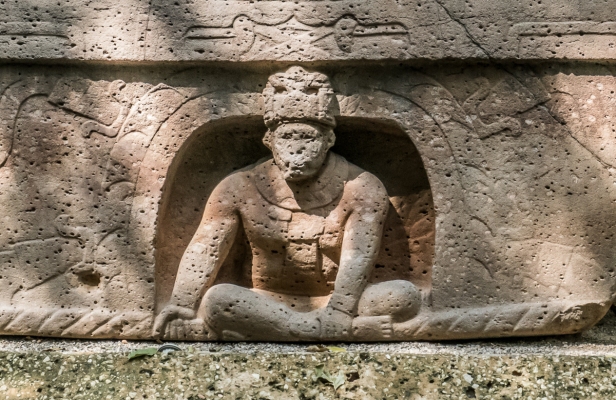
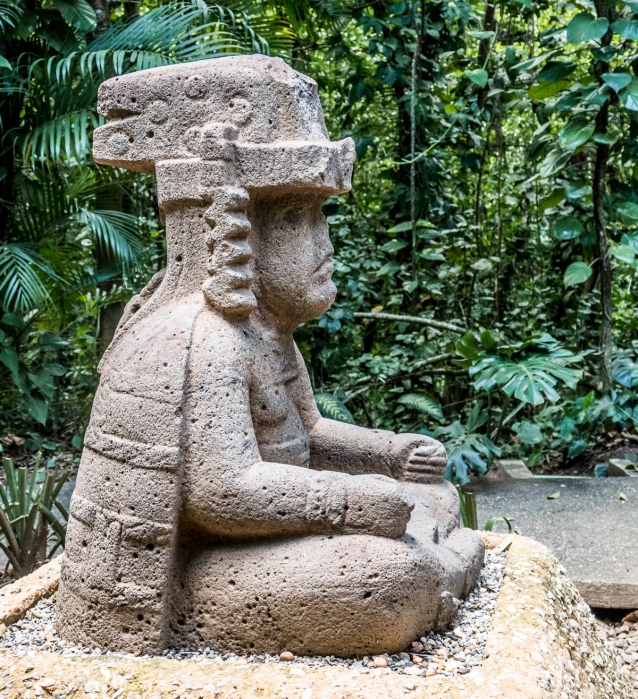
dozens of marauding coatis roaming freely, and a very sad zoo with some playful spider monkeys.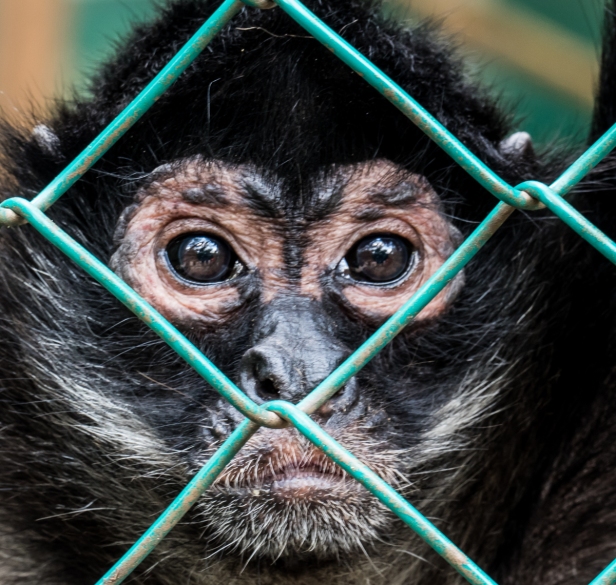
I say hello to some close cousins of the tiger, my animal totem: a black panther,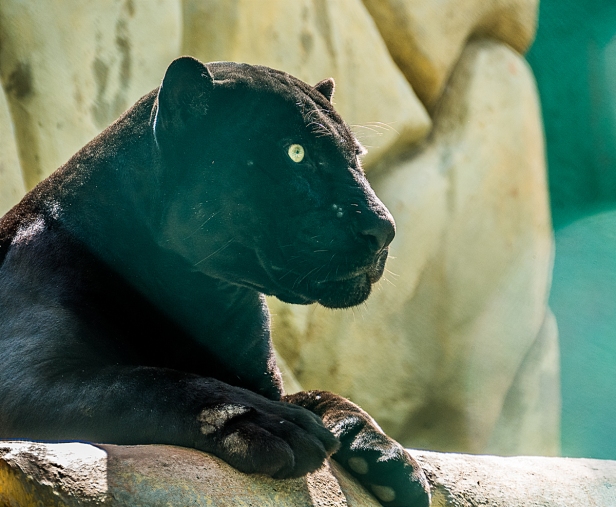
and a couple of jaguars who at least are playing with each other a little as cats do.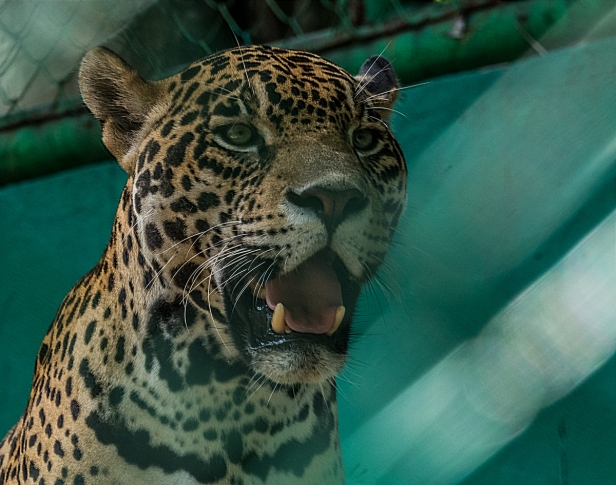

The next day we get on a bus and go to the extraordinary Mayan ruins of Palenque.
Next post: the Grande Fiesta de Enero at Chiapa de Corzo – a festival as only the Mexicans do them – crowds, colour, parades, masks, men in drag, women in dresses to die for, rainbow serapes, and wigs that look like toilet brushes.
All words and images by Alison Louise Armstrong unless otherwise noted
© Alison Louise Armstrong and Adventures in Wonderland – a pilgrimage of the heart, 2010-2017.

We’re currently watching a PBS 3-part series, Highwaymen, Pirates, and Rogues. Just watched the pirates episode last night. Fascinating. Mostly about Europe though, so this makes a nice addition to our ‘education’…
LikeLiked by 1 person
We were pretty interested in the whole pirate story, and there’s a tiny museum in the “Land Gate” fort that we went into that told some of it. And now it’s such a beautiful peaceful place. We loved it, as I’m sure you’ve gathered. Back in Van Mar 1 – hope the snow’s gone by then!
Alison
LikeLike
Intetesting article and superb photos! For me that I’m portuguese it’s interesting to see and discover my country’s legacy around the world, thank you for sharing! Happy travels, PedroL
LikeLiked by 1 person
Thanks so much petrol, I’m glad you enjoyed it. Bartolomeu Português was a pretty wild dude I think!
Alison
LikeLiked by 1 person
Dontcha just love autocorrect! 🙂
Of course I meant pedrol, not petrol!
LikeLike
ahah I agree with you Alison, for me is still impressive how all these men went to the discoveries, in such bad conditions… well, but today they are still remembered, that’s a fact! 🙂 PedroL
LikeLiked by 1 person
Aha! So your name is Pedro! I should have guessed 🙂
And yes, I too am impressed with what the men of that era, and earlier, discovered in such conditions.
Alison
LikeLiked by 1 person
🙂
LikeLiked by 1 person
Love Campeche post. Thanks again.
LikeLiked by 1 person
Thanks so much Keith, my pleasure.
Alison
LikeLike
Fascinating history lesson on Campeche and its fortification. I can’t get over the colours of the buildings. Your description of the place as a pastel frosted fairyland is so perfect. Beautiful malecon too. More reasons for us to return to Mexico!
LikeLiked by 1 person
Thanks Caroline. I too was smitten by the colours of the buildings. I immediately felt a simple joy just being there. And yes, the malecon is lovely.
Back in Van Mar 1 – hoping for NO SNOW!
Alison
LikeLiked by 1 person
Apparently snowing right now. We are in Cambodia. Back on Feb 25.
LikeLiked by 1 person
Woohooo Cambodia! Hope you’re having a great time! Will catch up with your blog soon.
LikeLike
You’ve got the knack for telling terrific travel stories. The ol’ wanderlust threatens to kick in.
LikeLiked by 1 person
Thank you so much keebslac! It is one of the compliments I value most. I feel I struggle with writing much more than photography so I’m always pleased when what I’ve written is received well – and well enough to inspire a little wanderlust! I don’t know if you’ve been to Mexico or not, but I highly recommend it as a very rich and varied destination.
Alison
LikeLike
Such astounding photos of your beautiful location. Having shovelled snow multiple times in the last 24 hours I feel like getting on a plane. Enjoy!
LikeLiked by 2 people
Thanks so much Sue. It’s such a beautiful place. And I’m soooo glad we didn’t have to spend this winter in Vancouver (which got about ten years worth of snow in one winter I think) let alone in Calgary! Still that snow shovelling is great exercise! Will have a lot to catch up on your blog, and everyone else’s, when we get back to decent wifi. Guatemala’s pretty bad, and Cuba probably will be worse.
Alison
LikeLiked by 1 person
Love the photos of Campeche…particularly your breakfast spot and the night shot. Looks tranquil and charming.
The photo of the sad monkey…not so much!
The history of forts is always interesting…the reasons for the need for protection in massive stone. Enjoyed the pirate history.
Peta
LikeLiked by 1 person
Thanks Peta. Yes, Campeche is exactly what you said – tranquil and charming. And I loved it’s pirate history, though maybe would not have liked it so much if I’d had to live through it!
Oh that zoo! It was awful. But surprisingly, despite the photo of the baby monkey watching us, the spider monkeys seemed to be happiest of all. There were quite a few of them and they were running and jumping all over the place in a quite big enclosure. The rest of it was pretty dire. It made me sad, especially for the big cats which I adore.
Alison
LikeLike
You’re going to feel right at home in Cuba – many similarities to how Campeche looks, although Campeche is far more polished. LOVE the photo of the pirate between the women on the bench. He looks almost real! Excellent post. Looking forward to the next!
LikeLiked by 1 person
Thanks Kelly. I think I’m going to really enjoy the shabby chic colours of Cuba. Campeche is very beautiful, but as you say, very polished. I love the way the women have just draped all their stuff over the pirate, as if he’s one of them. Haven’t been reading anyone’s blogs – not enough time and crappy internet – so lots to catch up on when I get back to Van. Praying for no more snow!
Alison
LikeLike
Stay away! 🙂 Another huge storm warning here for tonight and tomorrow. Freezing rain, whatever that is! Do you follow Andrew Seal? He’s a Vancouverite who posted some beautiful photos after the snow. When you’re back in range, check out this post: https://thechangingpalette.com/2017/02/08/escape-with-me/ Bye for now! -K.
LikeLiked by 1 person
Lovely colours and perspectives of the houses…and it was -34 here this morning so you enjoy and share more beauty…live the sky and soft clouds…have fun Alison ☺ and Don too! Smiles Hedy ☺
LikeLiked by 1 person
Thanks Hedy. So grateful to be in +34 not -34! But I bet you still find beauty everywhere. Hope you’re having lots of winter fun anyway. Smiles back to you.
Alison
LikeLiked by 1 person
froze some flowers so maybe…it’s -18 now balmy 🙂 enjoy your post is so warming…have fun Alison!!!! sunshine ~ smiles hedy
LikeLiked by 1 person
great photogallery
LikeLiked by 1 person
Thank you so much.
Alison
LikeLike
What a charming place ! Looks so much like a movie set as you say. The pirate seems to be a ladies’ man.
LikeLiked by 1 person
Yes, a very charming place. I was smitten from the first moment. I think that pirate likes his place there on that bench when all the local ladies come to hang out!
Alison
LikeLike
I can see why Campeche had you from the get-go. Great shots.
LikeLiked by 1 person
Thanks Peggy. Yes, it had me from the get-go – so beautiful, well maintained, and quite sophisticated. Campeche in Mexico’s colonial past, Villahermosa is Mexico in the raw.
Alison
LikeLike
What an awesome photo tour! I’m planning a trip to Mexico this summer… I didn’t originally plan on visiting this destination, but i might just have to find a way to make it work!
LikeLiked by 1 person
Thanks so much Eva. I hope you enjoy Mexico. We’ve been four times now, each time to different places and have never been disappointed. It’s a very rich culture with a lot of variety and an amazing indigenous and colonial history. Definitely worth visiting.
Alison
LikeLike
Thanks for the background information about Campeche. It looks like a very nice and relaxed place to visit. Also the colors of all the buildings add a unique touch. Thanks for the post.
LikeLiked by 1 person
You’re welcome, I’m glad you enjoyed it. Campeche is indeed very relaxed, and very beautiful with all the different colours. We liked it very much.
Alison
LikeLike
I’d like to go back to that side of Mexico as it has been many, MANY years. Campeche looks beautiful. Your photos are wonderful to go along with the excellent storytelling.
LikeLiked by 1 person
Thanks Debbie. We really enjoyed our whole time in the Yucatan. I still have a few more posts from that part of the country – a festival in Chiapa de Corzo, and San Cristobal de las Casas in Chiapas. There’s so many amazing places and cultures in Mexico. You’ll no doubt find a lot changed over the years, but still much is as it has been for hundreds of years. In Chiapas especially the traditions are maintained, especially in the villages.
Alison
LikeLiked by 1 person
Oh, I love a good walled city! Especially one with colorful old buildings inside it. This one reminds me of Cartagena, also a charmer. Sorry to hear Villahermosa was not so hermosa, but that lake view looks pretty sweet. Can’t wait to hear what you think of Cuba!
LikeLiked by 1 person
I loved walled cities too, and this one is especially good since there’s so much of the wall – either original or reconstructed. I never did get to Cartagena even though I spent 10 days at the beach nearby about a million years ago. Villahermosa fulfilled its purpose as a stopover and to see the Olmec heads. Excited about Cuba! We fly in there next Monday.
Alison
LikeLiked by 1 person
Amazing photos and write-up. Love this.
LikeLiked by 1 person
Thanks so much Arlene. I’m glad you enjoyed it.
Alison
LikeLike
Great post. I think you did Campeche justice with your photos and writing. Inside the city walls is an oasis, and we certainly chilled out there a few days too. The town square is one of the most beautiful in Mexico, and that is saying something.
LikeLiked by 1 person
Thanks Jeff. I was completely smitten with Campeche – such an oasis. We really enjoyed it. Will be catching up on your posts soon.
Alison
LikeLike
It’s pretty interesting place. I love the pics. 🙂
LikeLiked by 1 person
Thank you so much. Yes, it is an interesting place, and so unexpected to find such a place in Mexico.
Alison
LikeLiked by 1 person
We just returned from three weeks in laidback Campeche yesterday; perhaps we crossed paths?
LikeLiked by 1 person
Wouldn’t it have been fun if we did?! Probably we didn’t – we left Campeche Jan 12 for Palenque. I liked your posts about it!
Alison
LikeLiked by 1 person
We loved Campeche too and spent several days there in February of 2013, enervated by the heat during mid-day but enjoying the early mornings and evenings. I loved the centuries-old fortified walls and history and thought the historical part of the city was beautiful, especially along the malecon and the main zocolo with the lovely cathedral. Our visit to Villahermosa was, like yours, an “also ran” and you may have photographed the only pretty place there. 🙂 It was a spectacular disappointment but the Olmec heads and carvings more than made up for it. They were amazing and your photos capture their mystery and power. Anita
LikeLiked by 1 person
Thanks so much Anita. We didn’t mind the heat in Campeche, and then one day there was even a wild wind and rain storm that blew all the furniture across the terrace at our hotel. It’s such a beautiful town – the colourful buildings, the walls, the malecon. We felt so soothed by it all. And I agree, the Olmec heads and other carvings made up for the lack of anything else in Villahermosa. We weren’t disappointed because we knew ahead of time that there was nothing to recommend it except for the Parque de La Venta.
Alison
LikeLike
This speaks enormous amounts to me, thank you for sharing! Great and colourful photos too
I wrote a blog post about PDA which takes a comical stance. Check it out and let me know what you think 🙂
https://wordpress.com/stats/day/tootinghustle.wordpress.com
LikeLiked by 1 person
Thanks so much, I’m glad you enjoyed it.
Alison
LikeLiked by 1 person
Wonderful photos and evocative writing as always Alison! I love the pirates hanging round town… 😉
LikeLiked by 1 person
Thanks so much Danila. I thought the pirates were pretty cool too.
Have a great time in Vietnam!
Alison
LikeLike
Loved reading about the history of this town, and the reason for those very large and forbidding (and kind of ugly) walls. It reminded me a bit of Cartagena, which is also incredibly beautiful and protected by some of the ugliest walls I’ve ever seen. 😉 As long as they do their job I guess. 🙂 Will definitely put this on the list for when we make a long overdue trip to Mexico.
LikeLiked by 1 person
Thanks Shelley, glad you enjoyed it. Those walls were definitely built to be functional without consideration for aesthetic! I guess they just wanted them up as quickly as possible. I’ve heard about the Cartagena walls but not been there – maybe one day. Mexico is fabulous. I highly recommend it.
Alison
LikeLike
I share your sentiments about Campeche and Villahermosa. We unfortunately were on our Ruins Tour during our stop in Campeche so didn’t have the luxury of seeing the city at a relaxing pace. Would love to go back again someday.
LikeLiked by 1 person
Hope you get back to Campeche one day, it’s such a gem, but I bet that ruins tour was pretty amazing! Hoping to catch up on your posts when we get back to Vancouver and good wifi.
Alison
LikeLiked by 1 person
I have not been posting much lately. I find it difficult to do when we are just sitting. I have been spending too much time focused on our political scene. It seems I have become a bit of an activist but I hope to remedy that as the weather allows us to do some hiking in some of the NP’s in CA.
LikeLiked by 1 person
I think 45 is a wakeup call for everyone to become an activist 🙂 Michael Moore has posted a 10 point list of what everyone (in the US) can do to be effective at creating change. I’m sure if you google it you’ll find it.
A.
LikeLiked by 1 person
I respect Michael Moore and have read his 10-point plan. I believe it is great to be informed but I find I need to step back once in awhile or keep a small paper bag with me to keep from hyperventilating. 🙂
LikeLiked by 1 person
Oh yes I understand. I also read an article about activism burnout and the need to take breaks. What times we live in.
A.
LikeLiked by 1 person
Who would have ever thought this insanity would be going on in the United States?
LikeLiked by 1 person
Yes, it’s all quite extraordinary.
LikeLike
Campeche is new to me Alison, but your photos suggest it is somewhere that begs to be seen. Seeing the Olmec carvings would be a real treat. Thanks, as always, for a great post. –Curt
LikeLiked by 1 person
Thanks Curt, and yes Campeche is definitely worth a visit – a really pretty and unique place. And the Olmec heads are fabulous! Will catch up on your posts when we get back to Vancouver and good wifi. Two weeks in Cuba coming up!
Alison
LikeLike
Ah, Cuba… I am excited to see what you find. Several folks I follow have now been there. –Curt
LikeLiked by 1 person
Wow incredible! I had no idea that Mexico had such beautiful towns reminiscent of Antigua! Loving these posts and hope to explore these places some day Alison!
LikeLiked by 1 person
Thanks Nicole. Mexico has many beautiful Spanish colonial cities – Guanajuato, San Miguel de Allende, Valladolid, Campeche, and several others. I hope you get to explore one day. We go to Cuba tomorrow!
Alison
LikeLiked by 1 person
Have an amazing time! You will love Cuba!!!
LikeLiked by 1 person
Beautiful. 🙂
LikeLiked by 1 person
Thanks Dani ❤
Alison
LikeLiked by 2 people